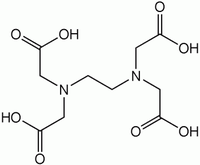EDTA
Definition of ethylenediaminetetraacetic acid (EDTA):
EDTA acid was patented in Germany in 1935. The molecule is a substituted diamine usually marketed as its sodium salts. At room temperature it occurs as a white powder. [1]
This is the common definition for ethylenediaminetetraacetic acid (EDTA), other definitions can be discussed in the article
|
Notes
| EDTA |
|---|

|
| Formula |
| C10H16N2O8 |
EDTA is mainly used in detergents and in the pulp and paper industry. Its use in Europe has increased in recent years from 26.000 tons in 1992 to 32.550 tons in 1997. Yearly 266 tonnes end of in river waste waters. [2]
In natural environments EDTA occurs as metal–EDTA complexes. It is very stable molecule, which is not very biodegradable. In fact in surface waters, the only significant process of removal of EDTA is the possibility of photolysis by sunlight. In water it has a high solubility of 500 g/l and is expected not to adsorb to particles or sediments. It doesn't bioaccumulate in any organism. EDTA however does bind metals and forms complexes with them. By doing so it enhances their mobility and bioavailability. EDTA can avoid the precipitation of heavy metals in solution and it can even cause heavy metals adsorbed in sediments to dissolve. The metal-EDTA complexes are assumed to be less toxic than the free metals themselves, except for cadmium and copper which might be more toxic when bound to EDTA. [1]
Acute toxicity can occur in fishes and algae at concentrations above 50 mg/l.
Concentrations in fresh surface waters are expected to be around 26 µg/l.[2]
Environmental standards and legislation
Included in the water framework list of priority substances
References
Please note that others may also have edited the contents of this article.
|